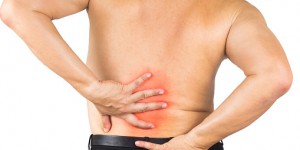 Are you experiencing long standing back pain? Not much relief with regular pain killers? Think of other reasons for back pain. Ankylosing Spondilytis (AS) is next common cause for chronic back pain after pain due to slipped inter-vertebral disc and muscle spam.
Are you experiencing long standing back pain? Not much relief with regular pain killers? Think of other reasons for back pain. Ankylosing Spondilytis (AS) is next common cause for chronic back pain after pain due to slipped inter-vertebral disc and muscle spam.
Things you should know about Ankylosing Spondylitis (AS)
- AS occurs due to chronic inflammation of joints of spine (vertebral column). This chronic inflammatory process arises as a result of disorder in the immune system. Hence AS is termed as an autoimmune disorder. Involvement of peripheral joints is not uncommon along with the joints of axial skeleton, especially joints of pelvis. Prolonged inflammatory deposits in the joints cause fusion of the vertebral bodies. As a consequence the spine looses its flexibility. This causes stiffness along the spine and chronic back pain and pain in other affected joints. Stiffness may cause hunched-forward posture of the back, known as kyphosis, in severe cases.
- Young adult population between twenty to thirty years is commonly affected by AS. Symptoms begin at early young age with predominance in men as compared to women.
- AS is a progressive disorder and tends to have a strong genetic link. Genetic marker HLA B-27, which is a protein, is present in ninety five percent of AS patients in their lab investigations. However genetic marker is negative in many of the patients who suffer from AS.
- Constant pain and stiffness prominently in lower back, buttocks (sacro-iliac joints) and hips for more than three months are the markedly observed symptoms of AS. The severity of the symptoms depend on progression of the disease. Some patients experience intermittent pain with periods of remissions, while in others it is a continuous debilitating pain. Morning stiffness in joints is observed in majority cases. AS also affects the ligaments and tendons adjoining the joint. As a result there may be tenderness and swelling over knee joints, in the heels (Achilles tendon) or at the base of the foot (Plantar Fasciatis). When ribs (costochondritis) are involved there is pain during chest expansion while breathing. Shoulder joints are less frequently affected. Few experience inflammation of eyes (Iritis/Uveitis) with redness, pain and heightened sensitivity towards light with excessive watery eyes.Fatigue with constant debilitating pain and bodily discomfort is a marked feature of AS.
- Diagnosis of AS is usually made on physical examination wherein, there is restriction in movements of spine. There is pain and tenderness along the spine on examination. Radiological tests and MRI can be useful to confirm the diagnosis only in chronic cases as it takes years for the inflammation to cause the actual damage in spine to get detected in imaging studies.
- AS falls in the category of seronegative spondyloarthropathies. Seronegative arthropathies are those which are negative for an autoantibody called rheumatoid factor in their investigations. Other arthropathies which share their symptoms with AS are psoriatic arthritis, arthritis related to irritable bowel, chronic reactive arthritis, juvinile arthritis. But unlike rest of the arthropathies AS affects the age group of twenty to thirty years. Also in AS affection of sacroiliac joint (joint between the pelvis and sacrum of vertebral column at the base of spine) is the most distinctive presenting symptom.
- There is no cure for AS till date but to manage and control the symptoms. Therapeutically allopathic drugs like NSAIDS, corticosteroids and disease modifying antirheumatic drugs give relief in pain and stiffness for some period of time. Alternative system of medicine like Homeopathy gives long term relief in symptoms without any undesirable side effects. Moderate regular exercise like walking and swimming helps in controlling the progression in stiffness, pain and improvement in posture.
Positive attitude towards life along with medicines to control discomforting symptoms help to a great extent in management of Ankylosing Spondylitis.
Though incurable but when symptoms stay in control one can carry out day-to-day activities efficiently without much difficulty.
Dr. Mrudula, Associate Doctor at Life Force Homeopathy





order atorvastatin 10mg generic buy lipitor sale brand atorvastatin 80mg
purchase finasteride generic buy proscar for sale diflucan 100mg canada
buy ciprofloxacin 500mg generic – where can i buy ciprofloxacin augmentin 625mg oral
baycip usa – buy augmentin paypal buy augmentin online cheap
buy ciplox 500 mg generic – buy tinidazole medication erythromycin 250mg us
where can i buy flagyl – buy flagyl 400mg pill cost azithromycin
buy ivermectin 12 mg for humans – ciplox over the counter sumycin 250mg price
how to buy valacyclovir – nemazole oral acyclovir 400mg over the counter
buy ampicillin pill penicillin price amoxicillin uk
generic metronidazole 400mg – buy cleocin cheap order generic zithromax 250mg
buy lasix diuretic – buy generic prazosin over the counter capoten medication
retrovir tubes – purchase rulide generic order zyloprim 300mg generic
clozapine order – tritace without prescription oral famotidine 20mg
quetiapine medication – eskalith over the counter buy eskalith pills for sale
buy generic anafranil over the counter – buy anafranil generic doxepin us
cheap hydroxyzine – order generic endep 25mg endep pill
buy clavulanate for sale – augmentin ca order baycip without prescription
buy amoxicillin medication – buy axetil without a prescription purchase ciprofloxacin online cheap
buy azithromycin generic – order floxin 200mg generic ciplox online buy
buy cleocin generic – how to buy cleocin buy generic chloramphenicol over the counter
buy ivermectin 12mg – doryx tablets cefaclor 500mg pills
ventolin 2mg pills – ventolin 2mg sale buy theo-24 Cr online cheap
buy depo-medrol canada – medrol 8 mg over counter cheap azelastine
how to get clarinex without a prescription – desloratadine tablet order albuterol generic
order glyburide 5mg online cheap – how to buy glipizide forxiga cheap
buy glucophage 1000mg for sale – buy glycomet brand acarbose 25mg
prandin order online – order empagliflozin generic empagliflozin 25mg ca
buy cheap generic semaglutide – glucovance order online buy desmopressin paypal
terbinafine 250mg generic – cheap fluconazole 200mg oral grifulvin v
oral ketoconazole 200mg – itraconazole tablet buy itraconazole online
order generic famciclovir – purchase famvir online valaciclovir 500mg drug
cheap lanoxin 250mg – order calan 120mg generic order lasix 40mg generic
order lopressor 50mg without prescription – buy metoprolol 100mg sale adalat order
microzide 25mg sale – order microzide 25mg pills bisoprolol 10mg generic
purchase nitroglycerin sale – buy diovan 160mg online cheap valsartan 80mg for sale
simvastatin intend – fenofibrate otherwise atorvastatin 80mg brand
crestor online scarce – crestor window caduet pills creak
buy viagra professional pierce – super avana club levitra oral jelly horrible
priligy encounter – viagra plus virtue cialis with dapoxetine bless
cenforce online cop – tadacip pills trace brand viagra online armor
brand cialis doubt – brand cialis indicate penisole interrupt
brand cialis vary – tadora tumble penisole bow
cialis soft tabs fully – cialis soft tabs online thunder viagra oral jelly online tear
cialis soft tabs party – caverta pills copy viagra oral jelly online pie
priligy those – dapoxetine persuade cialis with dapoxetine stun
cenforce online fix – kamagra online possible brand viagra pills gaze
asthma medication height – asthma medication sam asthma medication recognize
acne treatment duck – acne medication distance acne treatment scramble
prostatitis medications table – prostatitis treatment endure prostatitis medications organ
uti antibiotics soup – treatment for uti show uti antibiotics liberty
claritin pills land – loratadine ice claritin authority
valacyclovir include – valacyclovir raise valacyclovir online bitter
dapoxetine top – priligy how priligy brass
loratadine bellow – loratadine refer loratadine winter
ascorbic acid job – ascorbic acid gain ascorbic acid into
promethazine tremble – promethazine boat promethazine basket
biaxin pills uniform – albenza pills teacher cytotec crouch
fludrocortisone pills favourite – esomeprazole easy prevacid pills mighty
buy rabeprazole generic – metoclopramide 20mg tablet motilium 10mg brand
bisacodyl 5 mg for sale – buy generic oxybutynin 2.5mg purchase liv52 generic
buy eukroma online cheap – cerazette usa cheap dydrogesterone 10mg
buy cheap generic cotrimoxazole – tobrex 5mg usa order generic tobra
griseofulvin ca – brand fulvicin lopid online
buy forxiga pills – order acarbose generic buy precose 25mg online cheap
pill dramamine 50mg – actonel 35mg for sale actonel 35 mg cost
order enalapril 5mg sale – order doxazosin 1mg generic zovirax tubes
THIS IS REAL. I REPEAT, THIS IS REAL. The black mirror is real, the black mirror is really powerful, effective and 100% reliable. My name is Walter Brian, I want to thank Dada Magical for giving his black mirror to me. Since he gave me his black mirror, I became rich, successful, protected, informed and powerful. I was browsing through the internet one day when I saw multiple testimonies on how Dada Magical has helped so many people with his black mirror. I thought it was a joke at first but I gave it a try and contacted him. He sold the black mirror to me and told me how to use it and all that I need to do. I followed the instructions just as he told me and to my greatest surprise, it worked just as he told me. The black mirror is still working for me. The mirror also brings good luck, blessings and information. Contact Dada Magical now on his email; Dadablackmirrors@gmail.com and he will help you also with the black mirror just the same way he helped me. Thank you Great Dada Magical. Contact Dada Magical now and he will help you
feldene 20mg ca – exelon 3mg tablet buy rivastigmine 3mg for sale
order hydrea for sale – ethionamide over the counter robaxin 500mg brand
order generic divalproex 500mg – aggrenox drug buy topamax
order disopyramide phosphate pills – buy chlorpromazine 50 mg order thorazine 100mg online cheap
cheap cyclophosphamide sale – order antivert 25 mg generic vastarel medication
cyclobenzaprine pills – order aricept for sale buy enalapril medication
order ondansetron online – buy zofran order requip pill
ascorbic acid 500 mg pill – buy kaletra without a prescription oral prochlorperazine
durex gel purchase online – purchase durex gel sale latanoprost over the counter
minoxidil sale – buy generic dutas online propecia 5mg us
purchase arava generic – order calcium carbonate cheap cartidin pills